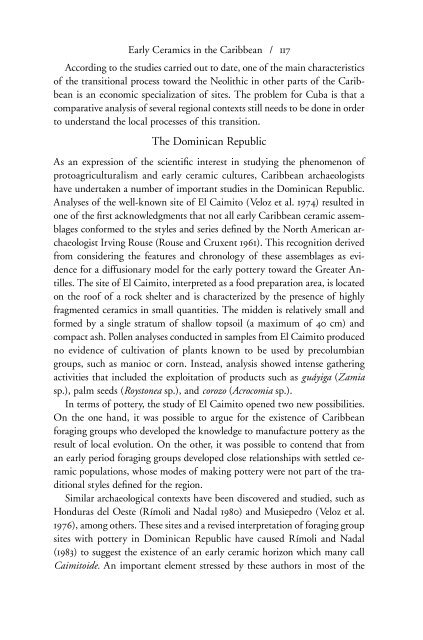Dialogues in Cuban Archaeology
by L. Antonio Curet, Shannon Lee Dawdy, and Gabino La Rosa Corzo
by L. Antonio Curet, Shannon Lee Dawdy, and Gabino La Rosa Corzo
Create successful ePaper yourself
Turn your PDF publications into a flip-book with our unique Google optimized e-Paper software.
Early Ceramics <strong>in</strong> the Caribbean / 117<br />
Accord<strong>in</strong>g to the studies carried out to date, one of the ma<strong>in</strong> characteristics<br />
of the transitional process toward the Neolithic <strong>in</strong> other parts of the Caribbean<br />
is an economic specialization of sites. The problem for Cuba is that a<br />
comparative analysis of several regional contexts still needs to be done <strong>in</strong> order<br />
to understand the local processes of this transition.<br />
The Dom<strong>in</strong>ican Republic<br />
As an expression of the scienti¤c <strong>in</strong>terest <strong>in</strong> study<strong>in</strong>g the phenomenon of<br />
protoagriculturalism and early ceramic cultures, Caribbean archaeologists<br />
have undertaken a number of important studies <strong>in</strong> the Dom<strong>in</strong>ican Republic.<br />
Analyses of the well-known site of El Caimito (Veloz et al. 1974) resulted <strong>in</strong><br />
one of the ¤rst acknowledgments that not all early Caribbean ceramic assemblages<br />
conformed to the styles and series de¤ned by the North American archaeologist<br />
Irv<strong>in</strong>g Rouse (Rouse and Cruxent 1961). This recognition derived<br />
from consider<strong>in</strong>g the features and chronology of these assemblages as evidence<br />
for a diffusionary model for the early pottery toward the Greater Antilles.<br />
The site of El Caimito, <strong>in</strong>terpreted as a food preparation area, is located<br />
on the roof of a rock shelter and is characterized by the presence of highly<br />
fragmented ceramics <strong>in</strong> small quantities. The midden is relatively small and<br />
formed by a s<strong>in</strong>gle stratum of shallow topsoil (a maximum of 40 cm) and<br />
compact ash. Pollen analyses conducted <strong>in</strong> samples from El Caimito produced<br />
no evidence of cultivation of plants known to be used by precolumbian<br />
groups, such as manioc or corn. Instead, analysis showed <strong>in</strong>tense gather<strong>in</strong>g<br />
activities that <strong>in</strong>cluded the exploitation of products such as guáyiga (Zamia<br />
sp.), palm seeds (Roystonea sp.), and corozo (Acrocomia sp.).<br />
In terms of pottery, the study of El Caimito opened two new possibilities.<br />
On the one hand, it was possible to argue for the existence of Caribbean<br />
forag<strong>in</strong>g groups who developed the knowledge to manufacture pottery as the<br />
result of local evolution. On the other, it was possible to contend that from<br />
an early period forag<strong>in</strong>g groups developed close relationships with settled ceramic<br />
populations, whose modes of mak<strong>in</strong>g pottery were not part of the traditional<br />
styles de¤ned for the region.<br />
Similar archaeological contexts have been discovered and studied, such as<br />
Honduras del Oeste (Rímoli and Nadal 1980) and Musiepedro (Veloz et al.<br />
1976), among others. These sites and a revised <strong>in</strong>terpretation of forag<strong>in</strong>g group<br />
sites with pottery <strong>in</strong> Dom<strong>in</strong>ican Republic have caused Rímoli and Nadal<br />
(1983) to suggest the existence of an early ceramic horizon which many call<br />
Caimitoide. An important element stressed by these authors <strong>in</strong> most of the


















